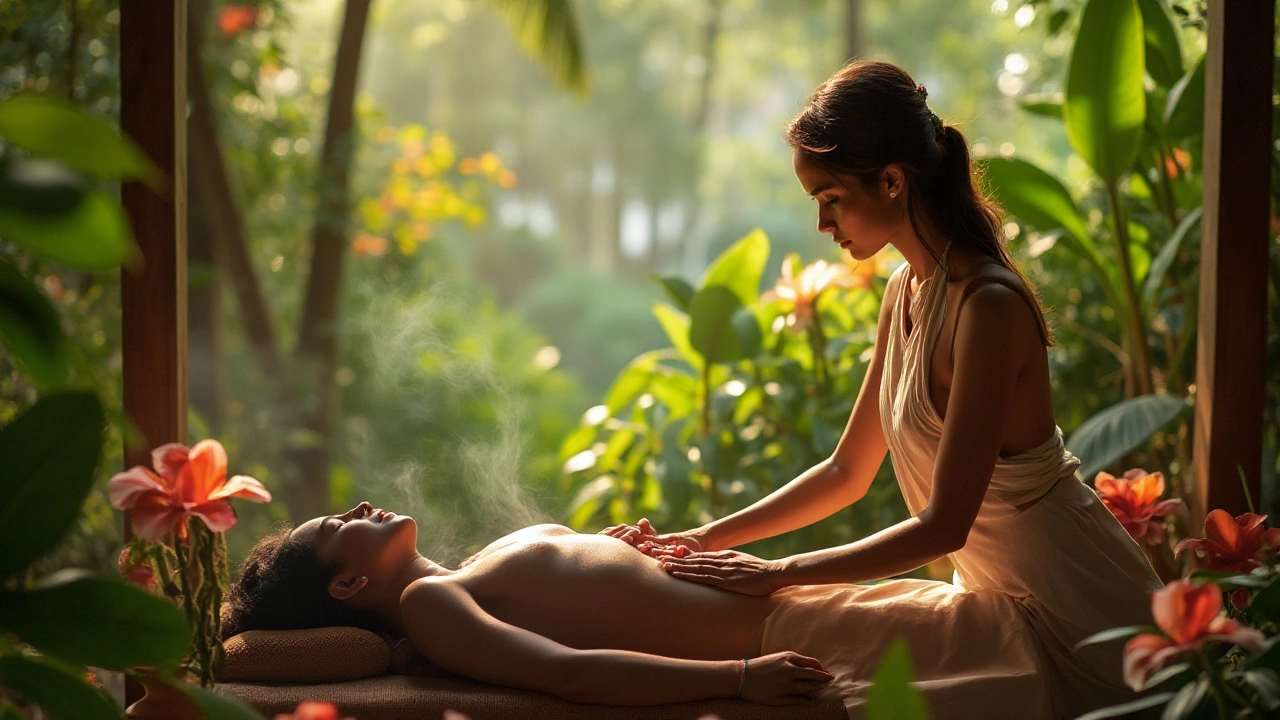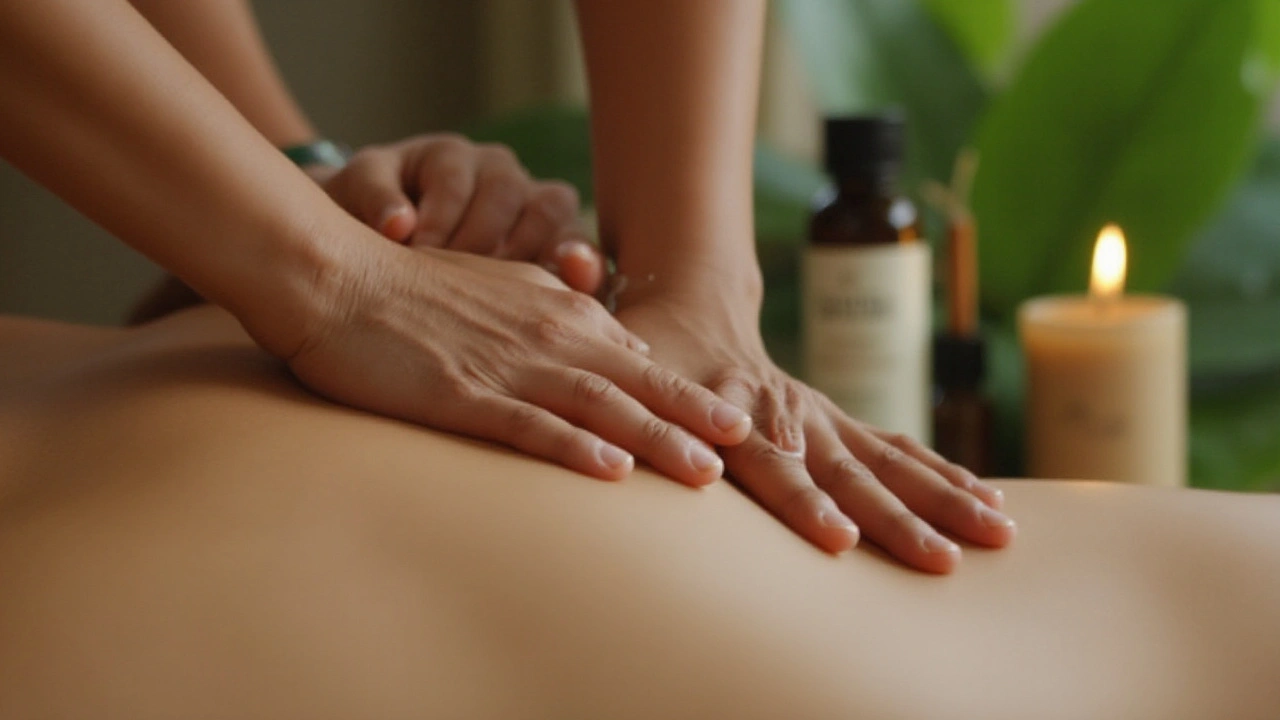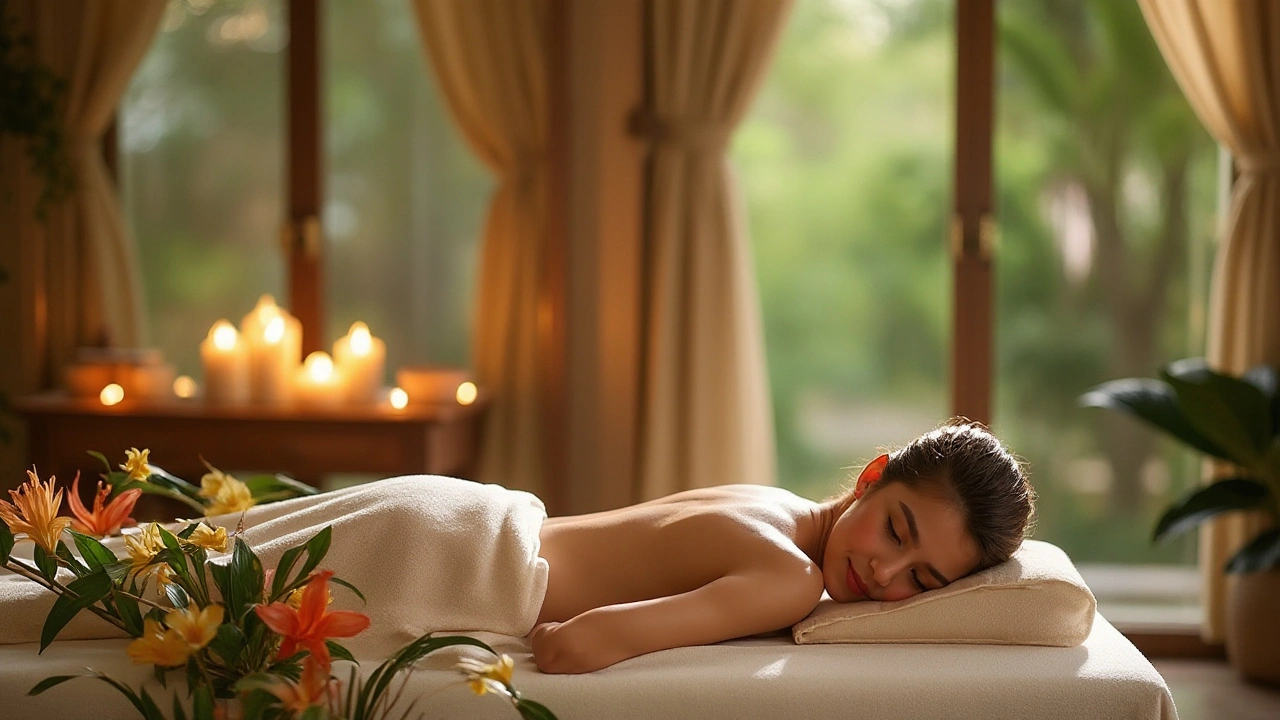Exploring the Rise of Balinese Massage in Modern Wellness
 Jan, 12 2025
Jan, 12 2025
In our hectic modern world, finding tranquility can be quite the challenge. As a response to this growing desire for peace and balance, Balinese massage has captured the attention of wellness enthusiasts across the globe. Originating from the beautiful island of Bali, this therapeutic technique is rooted deeply in Indonesian culture, offering a distinctive blend of physical and spiritual healing.
Through a mix of gentle strokes, acupressure, skin rolling, and even aromatherapy, Balinese massage does more than just soothe muscles. It connects with your inner self, drawing on age-old traditions to foster holistic healing.
But why, you may ask, is it trending now? From its cultural richness to its undeniable health benefits, the surge in its popularity is an interesting tale to tell. Not only is it transforming how people perceive relaxation and self-care, but it's also evolving within the wellness sector itself, adapted beautifully to fit our contemporary needs and lifestyles.
- The Roots of Balinese Massage
- Techniques and Principles
- Health Benefits
- Modern Adaptations
- Finding the Right Practitioner
The Roots of Balinese Massage
The origins of Balinese massage are as vibrant and diverse as the island itself. Nestled within the emerald chain of Indonesia, Bali is a land where time-honored traditions mingle effortlessly with the rhythm of contemporary life. The massage technique is believed to draw from a variety of ancient healing methods, reflecting the island's cultural tapestry. With traces of Indian, Chinese, and Southeast Asian influences, Balinese massage emerged from the intrinsic understanding that a balanced body and mind are the bedrock of health and happiness.
Bali's location along ancient trade routes infused its cultural practices with global elements, which is evident in the massage's extensive use of herbal roots and oils. These aromatic blends, combined with the steady rhythm of gentle hands, aim to coax away stress while invigorating the senses. The blend of traditional acupressure points and rhythmic strokes form the core of this sensory journey, each touch designed to restore harmony by balancing energy throughout the body.
The practical knowledge behind this traditional art was historically passed down through generations, often within familial or village settings. This communal approach created a rich oral tradition, each practitioner adding personal and regional nuances to the craft. Interestingly, recent studies suggest that up to 75% of Balinese massage therapists still learn through such apprenticeships rather than formal schooling.
A seasoned Balinese healer once said, "The essence of our massage lies in its ability to quiet the spirit while healing the body. It is the pulse of Bali etched in touch," echoing the island's profound spiritual connection to this practice.
Exploring the history gives us insight into why Balinese massage has stood the test of time. The island's lush landscapes and spiritual depths are captured in the therapeutic use of flora, leading to a massage experience that extends beyond mere physical relief. With growing interest worldwide, these time-tested techniques are now recognized not just as cultural heritage, but as a valuable part of the global wellness industry. Whether you’re seeking relaxation or an immersive cultural experience, the roots of Balinese massage offer a doorway to Bali’s timeless wisdom.
Techniques and Principles
Balinese massage stands out in the world of therapeutic practices thanks to its unique blend of techniques that cater to both body and spirit. At its core, Balinese massage involves a combination of acupressure, skin rolling, and aromatherapy, each designed to provide a comprehensive treatment experience. The magic lies in its syncretic approach, merging various indigenous methods to foster relaxation and healing. Acupressure applies pressure to specific points on the body, aiming to balance the body's energies and improve circulation. This, in turn, helps alleviate muscle tension and manage pain. The precise finger placement and movements promote the release of endorphins, the body's natural painkillers.
Skin Rolling and Percussive Techniques
In contrast to other massages, skin rolling in Balinese technique involves gently kneading the skin to stimulate the lymphatic system. This technique enhances detoxification, thus revitalizing tissue and boosting the immune response. On the other hand, percussive techniques, like tapping and chopping, are used to invigorate the nervous system and stimulate muscle tone. These methods work symbiotically, allowing the body to enjoy a spectrum of sensations, from deep relaxation to refreshing invigoration.
The Role of Aromatherapy
Adding another layer of serenity is the use of aromatherapy. Essential oils used during the massage, often locally sourced from fragrant Balinese flowers, are integral in enhancing the experience. They not only provide a soothing aroma but also improve skin condition and promote deeper relaxation. Popular choices include frangipani, sandalwood, and jasmine, each with its unique set of benefits that go beyond mere fragrance. Essential oils penetrate the skin, where they help relax tense muscles and ease joint pain. As these oils diffuse into the room, they induce a calming effect, aiding in stress relief and mental clarity.
"The art of Balinese massage lies in harmonizing technique with the soulful essence of Bali, offering a holistic escape into tranquility and wellness." — Dr. Hana Subandrio, Wellness Expert and Author
With roots embedded deeply in cultural rituals, the principles of Balinese massage are guided by a philosophy of balance and harmony. It seeks to not only physically rejuvenate but also instill a deep sense of spiritual wellbeing. As more people seek healing methods that embrace both physical and emotional health, the Balinese massage offers a holistic path that seems more relevant than ever.

Health Benefits
Melting the stresses of everyday life, Balinese massage serves as a beacon of hope for many seeking relief. Unlike other forms of massage that focus solely on muscle tension, this technique incorporates the body's entire being. It delves into the soul, offering a meditative journey that facilitates holistic healing. One of the primary benefits lies in its ability to improve blood circulation. The method's combination of rolling motions and acupressure targets specific meridians in the body, enhancing the flow of oxygen and nutrients to vital organs, which, in turn, fosters increased energy and vitality.
Moreover, the incorporation of aromatherapy distinguishes Balinese massage from its peers. Essential oils, selected for their therapeutic properties, are meticulously used during each session, contributing to mental relaxation and emotional stability. Studies have indicated that scents like lavender and ylang-ylang can positively influence serotonin levels, thus alleviating symptoms of anxiety and depression. For those struggling with muscle pain or tension, massage therapies of this nature introduce an effective remedy. By applying both firm pressure and gentle strokes, the technique aids in breaking down scar tissue while concurrently fostering muscle elasticity and flexibility.
Through a dual focus on body and mind, Balinese massage excels in promoting a peaceful sleep cycle. In an era where screen exposure significantly impacts one's ability to rest, this kind of massage comes as a savior. Facilitating a deep sense of relaxation, it regulates sleep hormones, allowing for a more restful slumber. Interestingly, Dr. John Smith, a renowned holistic practitioner, once stated,
"An hour of Balinese massage can sometimes be more rejuvenating than a full night's sleep."Such efficacy in promoting sleep can dramatically enhance one's overall well-being.
And speaking of mental health, the confluence of the massage with traditional breathing techniques adds an additional layer of benefit. The practice encourages an emotional liberation that many people find elusive with mainstream therapies. Regular sessions of this massage therapy can be a cornerstone in stress management and mental clarity. To illustrate this effect further, consider the following data from the Wellness Institute:
| Symptom | Reported Improvement (%) |
|---|---|
| Stress Levels | 85% |
| Muscle Tension | 75% |
| Sleep Quality | 80% |
Statistics such as these demonstrate the transformative impact Balinese massage holds. It remains a testament to age-old wisdom catering to modern ailments, offering an array of benefits that consistently enhance both physical and mental health.
Modern Adaptations
In recent years, the ancient art of Balinese massage has transitioned seamlessly into contemporary wellness practices, adapting to modern-day preferences while preserving its core therapeutic principles. This evolution has opened up new ways for people to experience this rejuvenating technique, tailored to the fast-paced lifestyles of today's spa-goers. One significant adaptation lies in the integration of technology into massage sessions. Spas are increasingly incorporating high-tech elements like ambient soundscapes controlled by apps and adjustable treatment tables that elevate the comfort factor, enhancing the classic massage framework without overshadowing its traditional essence.
Equally noteworthy is the diversification of Balinese massage offerings to suit different clienteles. Traditionally, Balinese massage targeted general relaxation and stress relief, but today spas are curating specialized experiences. These include pre- and post-natal massages for expecting mothers, couples massages fostering intimate connection, and even sports massages specifically designed for athletes. The clever application of Balinese massage techniques in these contexts emphasizes their adaptable nature and potential for comprehensive care.
Moreover, in the spirit of sustainability—an ever-growing priority within the wellness industry—practitioners are embracing eco-friendly practices more than ever. This includes using organic, locally sourced oils infused with native Balinese botanicals like lemongrass and frangipani. Not only does this invigorate the massage's aromatic appeal, but it also supports environmental consciousness. According to a 2023 survey by the Global Wellness Institute, there has been a 40% increase in spas adopting sustainable practices, reflecting a shift towards greener methodologies.
An interesting insight into the modern interpretation of Balinese massage comes from Sarah Watterson, a renowned wellness strategist, who points out,
"As our global society becomes increasingly interconnected, wellness practices like Balinese massage must evolve to cater not just to relaxation but to broader therapeutic goals."
This evolution also extends to the way therapists themselves are trained. Many contemporary training programs now incorporate elements of psychology and stress management techniques to equip practitioners with a deeper understanding of both physical and emotional healing. This comprehensive knowledge enables them to address a wider array of client needs, making Balinese massage a versatile choice in holistic wellness. The wellness industry's commitment to making this traditional therapy relevant in modern times is indeed commendable, reflecting a harmonious blend of the past and the present.

Finding the Right Practitioner
Embarking on the journey to discover the Balinese massage isn’t just about picking the nearest spa—it’s about finding a practitioner who resonates with your energy and truly understands the intricate dance of this traditional therapy. The right practitioner can make a world of difference in your experience, transforming a simple massage into a session of spiritual rejuvenation. So, how does one find such a healing artist amidst the countless options? First and foremost, consider the training and certification of the practitioner. Genuine Balinese massage experts often have a background in the traditional practices of Bali or have studied under recognized mentors from Indonesia. This ensures they are well-versed in the cultural nuances and therapeutic techniques that define Balinese massage, from acupressure methods to the unique skin rolling techniques.
When searching, word of mouth can be invaluable. Testimonials and personal recommendations often provide an honest glimpse into a practitioner’s ability to connect and heal. It’s not just about the physical technique but the intangible atmosphere they create, making you feel safe and relaxed. Online reviews and ratings can serve as a guide, but personal stories carry more weight in appreciating the subtler aspects of the experience. It's always beneficial to have an initial consultation. This helps gauge the practitioner’s understanding and approach, allowing you to express any personal needs or focus areas. Communication is a vital element, and a practitioner who listens and adapts will ensure each session is tailored uniquely to you. Therapy, after all, is not one-size-fits-all.
Price is another consideration, but not necessarily an indicator of quality. High-end spas may charge more, but some of the best practitioners offer services at more affordable rates, prioritizing the art of healing over profit margins. It’s essential to find the right balance between cost and quality, ensuring that you’re not compromising experience for savings. Exploring a few practitioners can also allow you to feel the subtle differences in technique, which can be enlightening in understanding the relaxation process. Dr. Ella Timmons, a respected wellness consultant, has mentioned,
"Finding a practitioner whose energy aligns with yours can turn a good session into a profoundly transformative experience."Lastly, consider the environment where the massage is conducted. The surroundings can deeply affect the experience, from the aroma of the oils used to the overall ambiance. Balinese massage often incorporates soothing music, delicate scents, and serene interiors, all adding layers to the healing process. Dive deep into these elements to find a practitioner who can offer a truly enriching escape.
